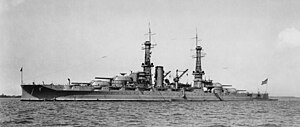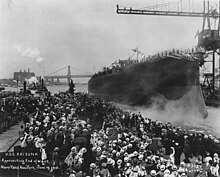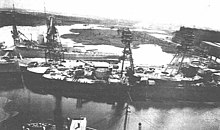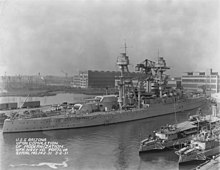USS Arizona
 Arizona during the 1920s
| |
| History | |
|---|---|
| Name | Arizona |
| Namesake | State of Arizona |
| Ordered | 4 March 1913 |
| Builder | Brooklyn Navy Yard |
| Laid down | 16 March 1914 |
| Launched | 19 June 1915 |
| Commissioned | 17 October 1916 |
| Decommissioned | 29 December 1941[1] |
| Stricken | 1 December 1942[1] |
| Identification | Hull number: BB-39 |
| Fate | Sunk during the attack on Pearl Harbor, 7 December 1941 |
| Status | Memorial wreck |
| General characteristics (as completed) | |
| Class and type | Pennsylvania-class battleship |
| Displacement | 29,158 long tons (29,626 t) (standard) |
| Length | 608 ft (185.3 m) |
| Beam | 97 ft (29.6 m) |
| Draft | 29 ft 3 in (8.9 m) (deep load) |
| Installed power |
|
| Propulsion | 4 shafts; 4 sets of steam turbines |
| Speed | 21 knots (39 km/h; 24 mph) |
| Range | 8,000 nmi (15,000 km; 9,200 mi) at 10 knots (19 km/h; 12 mph) |
| Complement | 1,087 (1,358 in 1931) |
| Armament |
|
| Armor | |
USS Arizona was a battleship built for the
The 1920s and 1930s saw Arizona regularly deployed for training exercises, including the annual
On 7 December 1941, the Japanese attacked Pearl Harbor, and Arizona was hit by several air-dropped armor-piercing bombs. One detonated an explosive-filled magazine, sinking the battleship and killing 1,177 of its officers and crewmen. Unlike many of the other ships attacked that day, Arizona was so irreparably damaged that it was not repaired for service in World War II. The shipwreck still lies at the bottom of Pearl Harbor beneath the USS Arizona Memorial. Dedicated to all those who died during the attack, the memorial is built across the ship's remains.
Description
The Pennsylvania-class ships were significantly larger than their predecessors, the

The ship had four direct-drive
Arizona carried twelve 45-
The Pennsylvania-class design continued the
The main armor deck was three plates thick with a total thickness of 3 inches; over the steering gear the armor increased to 6.25 inches (159 mm) in two plates. Beneath it was the splinter deck that ranged from 1.5 to 2 inches (38 to 51 mm) in thickness.
Construction and trials

The
The New York Times estimated that 75,000 people attended the launch, including
Arizona was commissioned into the Navy on 17 October 1916 with Captain John McDonald in command.[18] She departed New York on 10 November 1916 after the crew had cleaned the ship and the propulsion system had been tested at the dock.[19] After declinating the ship's magnetic compasses, the ship sailed south for her shakedown cruise. Outside Guantanamo Bay, a stripped turbine on 7 December forced the navy to order Arizona back to New York for repairs, although she was able to enter Chesapeake Bay to test her main and secondary gun batteries on 19–20 December. The turbine could not be repaired inside the ship, so the yard workers had to cut holes in the upper decks to lift the damaged casing out. It was reinstalled after almost four months of repairs at the naval yard.[20]
World War I
Arizona left the yard on 3 April 1917,[21] and three days later, the United States declared war on Germany. Assigned to Battleship Division 8 operating out of the York River,[21][22] Arizona was employed only as a gunnery training ship for the crewmen on armed merchant vessels crossing the Atlantic in convoys. Shortly after the war began, eight of her 5-inch guns (the four guns farthest forward and the sternmost four guns) were removed to equip merchant ships. When the ship sailed near the wreck of the old San Marcos (ex-Texas), the wreck was sometimes used as a target for the 14-inch guns. Arizona rarely ventured into the ocean for fear of U-boats, and when she did, it was only in the company of other battleships and escort ships. Four coal-fired American dreadnoughts (it was easier to obtain coal than oil in the United Kingdom) were eventually sent across the Atlantic in December 1917 as Battleship Division Nine, but Arizona was not among them. Life for Arizona's crew was not all training, as the race-boat team from Arizona was able to win the Battenberg Cup in July 1918 by beating the team from Nevada by three lengths over the three-mile course.[23]
The fighting ended on 11 November 1918 with
Post-war and the 1920s

Arizona sailed from New York for Hampton Roads on 22 January 1919; she continued south to Guantanamo Bay on 4 February and arrived on four days later.
When the crisis abated, Arizona was ordered to Constantinople (now Istanbul) before she sailed for home on 15 June. She put into the New York Navy Yard on 30 June for an overhaul, where six 5-inch guns were removed and the fire control system was modernized. Work was completed in January 1920 and the battleship sailed south to Guantanamo Bay for crew training. During this time, Arizona was fitted with a flying-off platform similar to the one given to Texas in March 1919. In April, Arizona lost the Battenberg Cup to Nevada, and in June she was present for the Naval Academy's graduation ceremonies. In August she became the flagship of Battleship Division Seven, although it was only later in 1920 that the battleship was refitted to be an admiral's flagship.[30]

In company with six battleships and eighteen destroyers, Arizona was sent south again to transit the
For the rest of the 1920s, Arizona's service consisted of routine training exercises. Naval historian Paul Stillwell remarked that "the Pacific years included a great deal of sameness and repetition", and his chronology of the ship's movements is filled with phrases like "torpedo-defense practice", "battle-practice rehearsal", "gunnery practice", "en route to…", and "anchored at…".[32] A recurring theme in these years were the annual Fleet Problems, which began in 1923 and simulated large fleet actions by having most of the active fleet face off against each other. The first two simulated an attack on the Panama Canal from the west, while in 1925 they attempted to defend the Hawaiian Islands. Other 1920s Fleet Problems included the Caribbean, near Central America, the West Indies, and Hawaii. On 27 July 1923 the ship, under command of John Y.R. Blakely, joined President Warren G. Harding's naval review in Seattle. Harding died just one week later, and Arizona joined the Pacific Fleet to fire a salute in his honor on 3 August.[21]
Sometime in early March 1924 a prostitute named
Modernization

Four months after
1930s


On 19 March 1931, even before Arizona was put through post-modernization sea trials, she hosted President Herbert Hoover for a brief vacation in the Caribbean. The President visited Puerto Rico and the Virgin Islands. Returning on 29 March, Arizona conducted her sea trials at Rockland, Maine, and had another catapult fitted on the top of Turret III, before she was transferred to the West Coast in August with her sister Pennsylvania. In February 1932, the ship participated in Grand Joint Exercise No. 4 in which carrier aircraft successfully attacked Pearl Harbor on Sunday morning, 7 February. After returning to the West Coast from Fleet Problem XIV in 1933, the ship was anchored in San Pedro when an earthquake struck nearby Long Beach, California, on 10 March. Sailors from the ship joined the relief efforts, providing food, treating the injured, and providing security from looters.[37]
In early 1934, the ship and her crew were filmed for the
Rear Admiral

On 2 January 1937, Rear Admiral
Arizona's last fleet problem was off Hawaii in April–May 1940. At its conclusion, the
Captain
Attack on Pearl Harbor

Shortly before 08:00 local time on 7 December 1941, Japanese aircraft from six
The aircraft scored four hits and three near misses on and around Arizona. The near miss off the port bow is thought to have caused observers to believe that the ship had been torpedoed, although no torpedo damage has been found. The sternmost bomb ricocheted off the face of Turret IV and penetrated the deck to detonate in the captain's pantry, causing a small fire. The next forward most hit was near the port edge of the ship, abreast the mainmast, probably detonating in the area of the anti-torpedo bulkhead. The next bomb struck near the port rear 5-inch AA gun.[48][Note 1]
Magazine explosion

The last bomb hit at 08:06 in the vicinity of Turret II, likely penetrating the armored deck near the magazines located in the forward section of the ship. While not enough of the ship is intact to judge the exact location, its effects are indisputable: about seven seconds after the hit, the forward magazines detonated in a cataclysmic explosion, mostly venting through the sides of the ship and destroying much of the interior structure of the forward part of the ship. This caused the forward turrets and conning tower to collapse downward some 25–30 feet (7.6–9.1 m) and the foremast and funnel to collapse forward, effectively tearing the ship in two.[50] The explosion touched off fierce fires that burned for two days; debris showered down on Ford Island in the vicinity. The blast from this explosion also put out fires on the repair ship Vestal, which was moored alongside.[51] The bombs and subsequent explosion killed 1,177 of the 1,512 crewmen on board at the time, approximately half of the lives lost during the attack.[21]
Two competing hypotheses have arisen about the cause of the explosion. The first is that the bomb detonated in or near the black-powder magazine used for the ship's saluting guns and catapult charges. This would have detonated first and then ignited the smokeless powder magazines which were used for the ship's main armament. A 1944 Navy Bureau of Ships report suggests that a hatch leading to the black powder magazine was left open, possibly with flammable materials stocked nearby. The Naval History and Heritage Command explained that black powder might have been stockpiled outside the armored magazine.[52] The alternative explanation is that the bomb penetrated the armored decks and detonated directly inside one of the starboard magazines for the main armament, but smokeless powder is relatively difficult to detonate. Thus the 14-inch powder bags required a black powder pad to quickly ignite the powder. The time elapsed from the bomb hit to the magazine explosion was shorter than experience suggested burning smokeless powder required to explode.[53] It seems unlikely that a definitive answer to this question will ever be found, as the surviving physical evidence is insufficient to determine the cause of the magazine explosion.[50][54]
Awards and recognition
After the attack, several sailors received medals for their conduct and actions under fire.
Salvage and memorial

Arizona was placed "in ordinary" (declared to be temporarily out of service) at Pearl Harbor on 29 December, and was stricken from the
Arizona memorials
It is commonly—but incorrectly—believed that Arizona remains perpetually in commission, like the

The wreck of Arizona remains at Pearl Harbor to commemorate the men of her crew lost that December morning in 1941. On 7 March 1950,
While the superstructure and two of the four main gun turrets were removed, the barbette of one of the turrets remains visible above the water.[61] Since her sinking, oil still leaks from the hull, with more than 2.3 quarts (2.18 L) escaping into the harbor per day.[65] In 2004, the US Navy and the National Park Service oversaw a comprehensive computerized mapping of the hull, being careful to honor its role as a war grave.[66] The navy considered non-intrusive means of abating the continued leakage of oil to avoid the further environmental degradation of the harbor.[67]
One of the original Arizona bells now hangs in the University of Arizona Student Union Memorial Center bell tower. The bell is rung after every home football victory, over any team except other Arizona schools.[68] A gun, mast, and anchor from Arizona are in Wesley Bolin Memorial Plaza just east of the Arizona State Capitol complex in downtown Phoenix, Arizona. The gun's plaque states that it was not on the ship during the Pearl Harbor attack, but was being relined for mounting on the battleship Nevada. It is paired with a gun from the battleship Missouri to represent the start and end of the Pacific War for the United States.[69] Other artifacts from the ship, such as items from the ship's silver service, are on permanent exhibit in the Arizona State Capitol Museum.[70]
Every two years the Navy awards "The USS Arizona Memorial Trophy" to a ship that has achieved the highest combat readiness in Strike warfare, Surface Fire Support and Anti-Surface warfare, as determined by the Chief of Naval Operations. The 3-foot-tall (0.91 m) bronze trophy on a black marble base was provided to the Navy by the citizens of the state of Arizona on 7 December 1987.[71]
Last survivor
The last survivor of Arizona, Lou Conter, died in April 2024 at the age of 102.[72]
See also
- USS Arizona salvaged artifacts
- USS Texas, the only extant WWI-era US Navy battleship remaining
- HMS Royal Oak, another battleship sunk in harbor by a surprise attack and now a war grave
Notes
Footnotes
- ^ The preliminary damage report, filed on 28 January 1942, listed seven bomb hits as well as one torpedo hit on the port bow forward. This last hit was based on a report from the captain of the repair ship Vestal moored alongside and could not be verified at the time. One bomb was thought to have gone down the stack, but this was contradicted when the ship's superstructure was salvaged in 1942 and the funnel cap was found to be intact.[49]
Citations
- ^ a b c d "Arizona (BB 39)". Naval Vessel Registry. 30 August 2001. Retrieved 16 November 2011.
- ^ a b c d e f Friedman, p. 440.
- ^ a b c Stillwell, p. 359.
- ^ a b Stillwell, p. 360.
- ^ Breyer, p. 214.
- ^ Stillwell, p. 305.
- ^ Wright, pp. 66, 123, 285.
- ^ Friedman, pp. 116, 440.
- ^ Stillwell, p. 19.
- ^ a b Friedman, pp. 115, 118, 440.
- ^ "Lay Keel of Navy's New Dreadnought," The New York Times, 17 March 1914.
- ^ Stillwell, pp. 3–5.
- ^ "Two Best Warships to be Built for US," The New York Times, 13 July 1913.
- ^ "Arizona Launching Here in Early June," The New York Times, 21 March 1915.
- ^ "50,000 to witness Arizona launching," The New York Times, 13 June 1915.
- ^ a b "Arizona Afloat as 75,000 Cheer". The New York Times. 20 June 1915.
- ^ "19-LC-19A-5: USS Arizona (BB 39)", navy.mil, retrieved 19 November 2021
- ^ "The Mighty Arizona Now a Part of Navy," The New York Times, 18 October 1918.
- ^ Stillwell, pp. 14–15.
- ^ Stillwell, pp. 16–21.
- ^ a b c d e f g h i j NH&HC, "Arizona"
- ^ Stillwell, pp. 21–22.
- ^ Stillwell, pp. 22–31.
- ^ Stillwell, pp. 36–37.
- ^ "Fleet Met Wilson Before Daylight," The New York Times, 14 December 1918.
- ^ "Battleship Fleet sails for New York," The New York Times, 15 December 1918.
- ^ "Ovation to Sea Fighters," The New York Times, 26 December 1918.
- ^ Stillwell, pp. 41–43.
- ^ Stillwell, pp. 44–45.
- ^ Stillwell, pp. 45, 48, 51, 56–57.
- ^ Stillwell, pp. 61, 64, 66–68.
- ^ Stillwell, pp. 69, 300–314.
- ^ Stillwell, pp. 74, 78–81, 303.
- ^ a b Friedman, pp. 197, 201.
- ^ Stillwell, p. 111.
- ^ Stillwell. pp. 110–111.
- ^ Stillwell, pp. 112–120, 124, 128–129.
- ^ Stillwell, pp. 133–142, 183, 185, 321.
- ^ Stillwell, pp. 190–91, 196, 322–331.
- ^ Stillwell, pp. 324–330.
- ^ Wohlstetter, pp. 80–81
- ^ Stillwell, pp. 217, 330–331.
- ^ Stillwell, p. 331.
- ^ Ruane, Michael (6 December 2016). "The USS Arizona wasn't supposed to be at Pearl Harbor, but it became America's most famous battleship". The Washington Post. Retrieved 3 February 2022.
- ^ Stillwell, p. 228.
- ^ "Battle of Midway, 3–6 June 1942 Composition of Japanese Naval Forces". Naval History And Heritage Command. 14 February 2018. Retrieved 22 July 2019.
- ^ Stillwell, pp. 274–276.
- ^ Stillwell, pp. 273–275.
- ^ Reproduced in Wright, pp. 275–276.
- ^ a b Stillwell, pp. 277–278.
- ^ Prange, pp. 513–514.
- ^ Wright, pp. 60–61, 287–288
- ^ Friedman, p. 6.
- ^ Stillwell, pp. 267–268.
- ^ Stillwell, p. 279.
- ^ Wright, pp. 78, 80.
- ISSN 0043-0374.
- ^ Wright, pp. 80, 84, 88.
- ^ "Nevada". Dictionary of American Naval Fighting Ships. Navy Department, Naval History and Heritage Command. Retrieved 17 October 2008.
- ^ a b c "History and Culture". National Park Service. Archived from the original on 28 October 2011. Retrieved 16 November 2011.
- ^ Stillwell, p. 281.
- ^ "USS ARIZONA Wreck". National Park Service. Archived from the original on 23 September 2011. Retrieved 16 July 2011.
- ^ "USS Arizona Interments". USS Arizona Preservation Project 2004. 18 December 2007. Archived from the original on 2 April 2015. Retrieved 16 November 2011.
- ^ "Baseline Environmental Data Collection". USS Arizona Preservation Project 2004. 18 December 2007. Archived from the original on 2 April 2015. Retrieved 16 November 2011.
- ^ "USS Arizona Preservation Project". USS Arizona Preservation Project 2004. 18 December 2007. Archived from the original on 2 April 2015. Retrieved 16 November 2011.
- ^ "USS Arizona Preservation Project FAQ". USS Arizona Preservation Project 2004. 18 December 2007. Archived from the original on 2 April 2015. Retrieved 16 November 2011.
- ^ "U.S.S. Arizona Bell". University of Arizona. Archived from the original on 1 September 2003. Retrieved 16 July 2011.
- ^ "Phoenix, Arizona – USS Arizona Anchor and Mast". Roadside America.com. 15 July 2011. Retrieved 16 July 2011.
- ^ "Flagship of the Fleet: Life and Death of the USS Arizona". Current Exhibits. Arizona Capitol Museum. Archived from the original on 6 April 2015. Retrieved 22 May 2008.
- ^ "OPNAVINST 3590.11F – Arleigh Burke Fleet Trophy, the Marjorie Sterrett Battleship Fund Award and USS ARIZONA Memorial Trophy" (PDF). 30 January 2007. Archived from the original (PDF) on 7 March 2016.
- ^ Goldstein, Richard (1 April 2024). "Lou Conter, Last Survivor of the Battleship Arizona, Dies at 102". New York Times. Retrieved 1 April 2024.
References
- Breyer, Siegfried (1973). Battleships and Battle Cruisers, 1905–1970. Garden City, New York: Doubleday. OCLC 702840.
- Campbell, John (1985). Naval Weapons of World War II. Annapolis, Maryland: Naval Institute Press. ISBN 0-87021-459-4.
- Friedman, Norman (1985). U.S. Battleships: An Illustrated Design History. Annapolis, Maryland: Naval Institute Press. ISBN 0-87021-715-1.
- "Arizona". Dictionary of American Naval Fighting Ships. Naval History & Heritage Command(NH&HC). 9 November 2004. Retrieved 20 November 2011.
- OCLC 48171319.
- Silverstone, Paul H. (1984). Directory of the World's Capital Ships. New York: Hippocrene Books. ISBN 0-88254-979-0.
- Stillwell, Paul (1991). Battleship Arizona: An Illustrated History. Annapolis, Maryland: Naval Institute Press. OCLC 2365447.
- OCLC 269470.
- Wright, Christopher C, ed. (March 2002). "The US Navy's Study of the Loss of the Battleship Arizona". Warship International. XXXIX–XL (3–4, 1). Toledo, Ohio: International Naval Research Organization: 44–105, 247–99, 360–80. ISSN 0043-0374.
Further reading
- Borneman, Walter R (2019). Brothers Down: Pearl Harbor and the Fate of the Many Brothers Aboard the USS Arizona. New York City: Little, Brown and Co. ISBN 978-0-316-43888-9.
- Gardiner, Robert; Gray, Randal (1985). Conway's All the World's Fighting Ships 1906–1921. London: Conway Maritime Press. ISBN 0-87021-907-3.
- OCLC 62324475.
- Jones, Jerry W (1998). U.S. Battleship Operations in World War I. Annapolis, Maryland: Naval Institute Press. OCLC 37935228.
- Madsen, Daniel (2003). Resurrection: Salvaging the Battle Fleet at Pearl Harbor. Annapolis, Maryland: Naval Institute Press. ISBN 1-55750-488-1.
- Raymer, Edward C. (1996). Descent into Darkness: Pearl Harbor, 1941: A Navy Diver's Memoir. Novato, California: Presidio Press. ISBN 0-89141-589-0.
- OCLC 51673398.
External links
- Photo gallery of USS Arizona at NavSource Naval History
- "USS Arizona: That Terrible Day". University of Arizona Special Collections.
- Historic American Engineering Record (HAER) No. HI-13, "USS Arizona, Submerged off Ford Island, Pearl Harbor, Honolulu, Honolulu County, HI", 5 photos, 4 measured drawings, 2 data pages, 1 photo caption page
- "Peer Into a Fallen Battleship at Pearl Harbor". YouTube. National Geographic. 7 December 2016.
